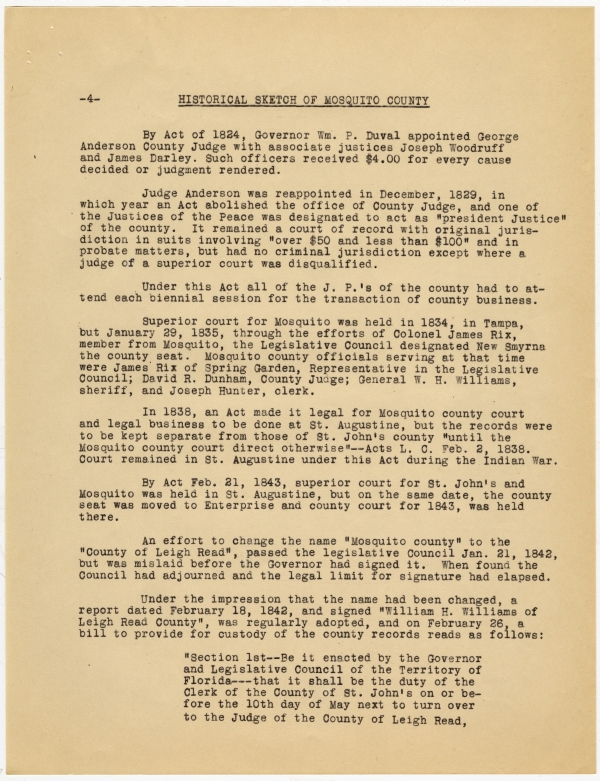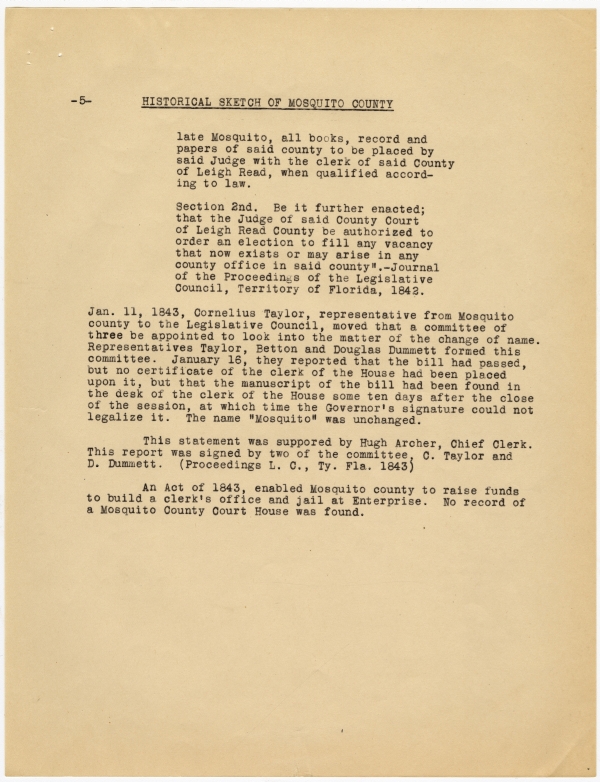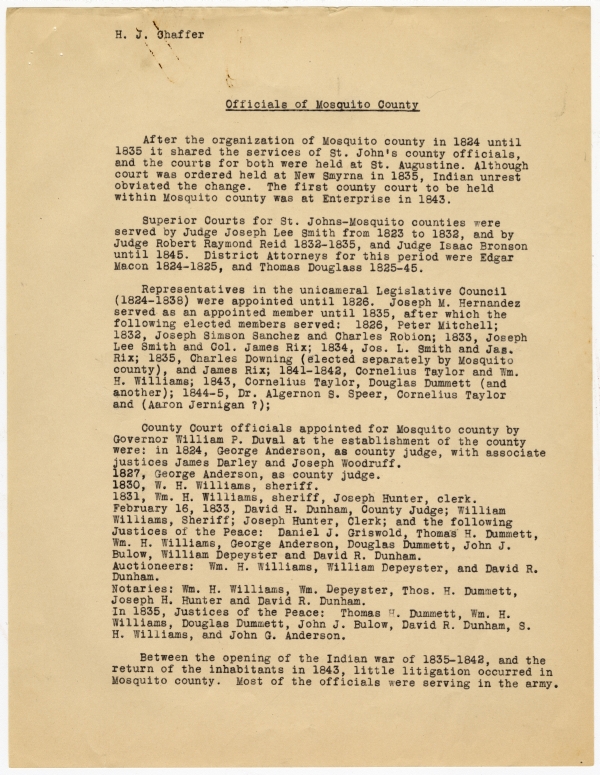Transcript
H. J. Chaffer
HISTORICAL SKETCH OF MOSQUITO COUNTY
Mosquito county was established by an Act of the Legislative County of the Territory of Florida. The signed approval of Governor William P. Duval on December 29, 1824, organized as a political unit that part of the peninsula of Florida south of the head of the southern branch of the Matanzas river. County courts for Mosquito county were ordered held the first Mondays of April and October at the house of John Bunch on the river Tomoko.
The county courts of Mosquito, Nassau, Alachua, Gadsden, Walton and Jackson counties, at their first sessions, with all six judges of these courts present and concurring, were ordered to appoint within their respective counties three discreet and impartial persons, two of which were to be chosen from the opposite extremes and one from the centre of the said counties, “as nearly as may be”, who were to examine and select the most convenient and eligible situation for the permanent seat of Justice for the said counties, respectively. These commissioners were ordered to report in writing all their proceedings to the county courts of their counties at such time and place as their respective courts might direct.
The name “Mosquito” survives “Los Mosquitoes”, the Spanish designation both the two lagoons that reach the Atlantic through Mosquito Inlet, and the neighbouring country. Under the English the northern branch was renamed the Halifax river in honour of George Montagu Dunk, Earl of Halifax; the southern, for the Earl of Hillsborough. The adjoining country, however, remained “The Mosquitoes”. It lay between the St. John’s River and that part of the east coast from the mouth of the Matanzas to the head of the Hillsborough. The original bounds of Mosquito county were “on the north by the County of St. John’s, on the East by the Atlantic Ocean, on the south by Monroe County, and on the West by the Indian Boundary line and the county of Alachua”.
As described in 1824, the line separating Mosquito County from St. Johns was from a “point on the Atlantic shore where it was intersected by the parallel of latitude passing from a point three miles south of the head of the Matanzas South River, at Fiske’ [sic] Landing, low water mark, thence westwardly to Dunn’s Lake, thence to the mouth of Sulphur Springs at the northwest side of Lake George, thence to the mouth of Deep Creek on the River Oklawaha and the line of Alachua County.”
The Mosquito-Alachua county line was from “a point on the Oklawaha river where Deep Creek enters the same thence up the western bank of the River Oklawaha to the point where the Indian boundary line intersects the same”.
-2- HISTORICAL SKETCH OF MOSQUITO COUNTY
From this point the Mosquito county line lay along the eastern line of the Indian boundary. From the map of Burgess and Honour, published in Brevard’s History of Florida, it appears to be near Eureka, thence southeasterly to cross the Wekiva river about 2 miles from its mouth, thence across the southwestern arm of Lake Jesup through Oveido, Christmas P. O., thence in a southerly direction to meet the northern boundary of Monroe county.
The Mosquito-Monroe county boundary is described by the Acts of the Legislative Council to extend “along the northern boundary of said Lake Macaco (Okeechobee) to its most eastern limits (about Port Mayaca) thence to the headwaters of the Potomac (Hillsborough) river, thence down said river to its entrance into the ocean,” or Jupiter Inlet.
In 1836, at the 14th session of the Legislative Council, part of the southern end of Mosquito county was cut off to form part of Dade. The Mosquito-Dade county line is described in the Act as from the south end of Lake “Macaco” in a direct line to the head of the north-prong or branch of the Potomac, commonly called the Hillsborough River, and down said river to the sea. (Approved Feb. 4, 1836)
St. Lucia county was cut from Mosquito March 6, 1836. The line it shared with Mosquito county began on the Atlantic coast “about 12 miles south of Ft. Ann (at the Haulover), at the terminus of the upper or northern parallel line just completed by Col. Washington, and run due west along said parallel line to the High Sand Hills, (commonly called Ahlanbatkee), between ranges 26 and 27 east”[.] Part of this line forms the present south bounds of Orange County.
In 1835, the Indian Reserve or “the Indian Nation” as it was called, was abolished, and the country composing it was divided among the adjacent counties. Although the Acts do not give the description of Mosquito county after this allotment, the bounds of the County of Marion next to Mosquito, are specified in the act by which it was established in 1844; “- - -from the mouth of Orange Creek at its junction with the [Ocklawaha] river, thence down said river to the range line dividing range lines 26 and 27, thence south along said line to Township line dividing Townships 21 and 22.” This point is in Lake Apopka some 2 miles east of Mt. Verde.
From this point in Lake Apopka the Hernando-Mosquito line in 1843, was described as a line running from the headwaters of the Withlacoochee to the head waters of the Hillsborough river”. A succeeding Act in 1844, made the “Meridian” line the Mosquito-Hernando boundary.
-3- HISTORICAL SKETCH OF MOSQUITO COUNTY
Prior to 1844, the description of Hillsborough county in the Acts gave merely “Mosquito county” as the eastern boundary, but in the Act of March 6, 1844, the Meridian was made the definite common boundary between them.
Mosquito county became Orange County by Act of January 30, 1845. It was approved February 6th, but before the Governor had signed it, Florida had become a state. By Act of July 16, 1845, the county seat was changed from Enterprise to “Mellonsville”, and the military buildings at Ft. Mellon were designated as the seat of justice.
The earlier settlers of Mosquito county lived along the Halifax river, the Hillsborough Lagoon, and along the St. Johns. Several of these had been Spanish subjects, who held land from the Spanish crown, and whose titles were confirmed by the United States Land Commissioners. Some held land acquired during the British Occupation and in 1815, had accepted the invitation of Governor Don Jose Coppinger to return to their estates. Others bought claims of the former residents and moved here.
Verifications of the titles held by these claimants are found in American State Papers, Public Lands, from these and the report of Charles Vignoles, who examined the country in 1821, for the U. S. Government, it appears that most of the owners of the “Province of the Mosquitoes”, lived in St. Augustine or elsewhere, and their plantations were managed by over-seers.
A few large owners, however, were here June 10, 1821, at the time of the change of flags. Of these were Mr. George Anderson who had been manager of “Mount Oswald” at Tomoka, John Bunch, his neighbour, Samuel Williams at Ormond, James Darly at Daytona, Horatio S. Dexter at Volusia, Col. James Rix (also spelled Rees and Reyes), and Joseph Woodruff at Spring Garden, two plantations of General Jose [Mariano] Hernandez, Mala Compra just south of Matanzas Inlet, and St. Joseph’s some miles further south of that. At Volusia in 1821, Vignoles states the plantation there (Dexter’s) was producing its second crop of sugar cane.
James Grant Forbes in his “Sketches of the Floridas” (p. 91), says that in 1821, Richard Oswald was growing sugar at Mt. Oswald at the mouth of the Tomoko. He employed Mr. George Anderson as his manager. This plantation passed to Don Gabriel Perpall of St. Augustine, who had other plantations at New Smyrna, Active in 1821, were those of Farquhar Bethune, Thomas McArdy, Stubbs and others.
-4- HISTORICAL SKETCH OF MOSQUITO COUNTY
By Act of 1824, Governor Wm. P. Duval appointed George Anderson County Judge with associate justices Joseph Woodruff and James Darley. Such officers received $4.00 for every cause decided or judgment rendered.
Judge Anderson was reappointed in December 1829, in which year an Act abolished the office of County Judge, and one of the Justices of the Peace was designated to act as “president Justice” of the county. It remained a court of record with original jurisdiction in suits involving “over $50 and less than $100” and in probate matters, but had no criminal jurisdiction except where a judge of a superior court was disqualified.
Under this Act all of the J. P.’s of the county had to attend each biennial session for the transaction of county business.
Superior court for Mosquito was held in 1834, in Tampa, but January 29, 1835, through the efforts of Colonel James Rix, member from Mosquito, the Legislative Council designated New Smyrna the county seat. Mosquito county officials serving at that time were James Rix of Spring Garden, Representative in the Legislative Council; David R. Dunham, County Judge; General W. H. Williams, sheriff, and Joseph Hunter, clerk.
In 1838, an Act made it legal for Mosquito county court and legal business to be done at St. Augustine, but the records were to be kept separate from those of St. John’s county “until the Mosquito county court direct otherwise”—Acts L. C. Feb. 2, 1838. Court remained in St. Augustine under this Act during the Indian War.
By Act Feb. 21, 1843, superior court for St. John’s and Mosquito was held in St. Augustine, but on the same date, the county seat was moved to Enterprise and county court for 1843, was held there.
An effort to change the name “Mosquito county” to the "County of Leigh Read”, passed the legislative Council Jan. 21, 1842, but was mislaid before the Governor had signed it. When found the Council had adjourned and the legal limit for signature had elapsed.
Under the impression that the name had been changed, a report dated February 18, 1842, and signed “William H. Williams of Leigh Read County”, was regularly adopted, and on February 26, a bill to provide for custody of the county records reads as follows:
“Section [1]st—Be it enacted by the Governor and Legislative Council of the Territory of Florida—that it shall be the duty of the Clerk of the County of St. John’s on or before the 10th day of May next to turn over to the Judge of the County of Leigh Read,
-5- HISTORICAL SKETCH OF MOSQUITO COUNTY
late Mosquito, all books, record and papers of said county to be placed by said Judge with the clerk of said County of Leigh Read, when qualified according to law.
Section 2nd. Be it further enacted; that the Judge of said County Court of Leigh Read County be authorized to order an election to fill any vacancy that now exists or may arise in any county office in said county”.—Journal of the Proceedings of the Legislative Council, Territory of Florida, 1842.
Jan. 11, 1843, Cornelius Taylor, representative from Mosquito county to the Legislative Council, moved that a committee of three be appointed to look into the matter of the change of name. Representatives Taylor, Betton and Douglas Dummett formed this committee. January 16, they reported that the bill has passed, but no certificate of the clerk of the House had been placed upon it, but that the manuscript of the bill had been found in the desk of the clerk of the House some ten days after the close of the session, at which time the Governor’s signature could not legalize it. The name “Mosquito” was unchanged.
This statement was [supported] by Hugh Archer, Chief Clerk. This report was signed by two of the committee, C. Taylor and D. Dummett. (Proceedings L. C., Ty. Fla. 1843)
An Act of 1843, enabled Mosquito county to raise funds to build a clerk’s office and jail at Enterprise. No record of a Mosquito County Court House was found.
St. Augustine Office, 3/10/37
With reference to your request for details concerning the District Supervisor’s letter asking for all the information possible relative to Mosquito County records in the records of St. John’s County, I submit the following.
Form 1821 until the creation of Mosquito County in 1824 all records of the territory which then was set off as Mosquito County would be in the so-called Miscellaneous Record, earliest deed books, and one or two court books. However, there would be no easy way of determining which of the 1821-24 records were for the later Mosquito section except where land descriptions showed it, or where some attorney casually specified in some way where complainants lived. In the Court records it was only necessary to say that the complainant was within the jurisdiction of the court and in those years litigants might have lived anywhere in East Florida and be thus designated.
It is possible for a long, assiduous search to determine which records are for territory later set off into new Counties, but there are no records of these counties, per se, in the St. John’s County records except where Circuit Court, [Appellate] or Special Courts heard a case which had come up to them from a Justice Court or such, or on a change of venue. These later types of cases are fairly easy to spot by close inspection, but of course are not the important ones.
If we had—the almost impossible—a list of residents of the territories later set off into new counties, we could readily sort the old court records with reference to the new counties’ boundaries by using the old book titled, “Index to Court Records” which is alphabetical by names of all parties to a case.
Summarizing, I would say, judging from my intimate inspection over several months, of these old records, that it would require a several week’s assignment after much preliminary work to secure names of such residents mentioned as were available, to classify these old records (though they cover comparatively [few] years) in the category of subsequent new counties.
(Mosquito County records, 1824 on, would seem to me to be found in present Orange County records, since it is not a “defunct” county, as the above mentioned letter named it, but its name was changed to Orange County in 1845).
H. J. Chaffer
Officials of Mosquito County
After the organization of Mosquito County in 1824 until 1835 it shared the services of St. John’s county officials, and the courts for both were held at St. Augustine. Although court was ordered held at New Smyrna in 1835, Indian unrest obviated the change. The first county court to be held within Mosquito county was at Enterprise in 1843.
Superior Courts for St. Johns-Mosquito counties were served by Judge Joseph Lee Smith from 1823 to 1832, and by Judge Robert Raymond Reid 1832-1835, and Judge Isaac Bronson until 1845. District Attorneys for this period were Edgar Macon 1824-1825, and Thomas Douglass 1825-45.
Representatives in the unicameral Legislative Council (1824-1838) were appointed until 1826. Joseph M. Hernandez served as an appointed member until 1835, after which the following elected members served: 1826, Peter Mitchell; 1832, Joseph Simson Sanchez and Charles Robion; 1833, Joseph Lee Smith and Col. James Rix; 1834, Jos. L. Smith and Jas. Rix; 1835, Charles Downing (elected separately by Mosquito county), and James Rix; 1841-1842, Cornelius Taylor and Wm. H. Williams; 1843, Cornelius Taylor, Douglas Dummett (and another); 1844-5, Dr. Algernon S. Speer, Cornelius Taylor and (Aaron Jernigan ?);
County Court officials appointed for Mosquito county by Governor William P. Duval at the establishment of the county were: in 1824, George Anderson, as county judge, with associate justices James Darley and Joseph Woodruff.
1827, George Anderson, as county judge.
1830, W. H. Williams, sheriff.
1831, Wm. H. Williams, sheriff, Joseph Hunter, clerk.
February 16, 1833, David H. Dunham, County Judge; William Williams, Sheriff; Joseph Hunter, Clerk; and the following Justices of the Peace: Daniel J. Griswold, Thomas H. Dummett, Wm. H. Williams, George Anderson, Douglas Dummett, John J. Bulow, William Depeyster and David R. Dunham.
Auctioneers: Wm. H. Williams, William Depeyster, and David R. Dunham.
Notaries: Wm. H. Williams, Wm. Depeyster, Thos. H. Dummett, Joseph H. Hunter and David R. Dunham.
In 1835, Justices of the Peace: Thomas H. Dummett, Wm. H. Williams, Douglas Dummett, John J. Bulow, David R. Dunham, S. H. Williams, and John G. Anderson.
Between the opening of the Indian war of 1835-1842, and the return of the inhabitants in 1843, little litigation occurred in Mosquito county. Most of the officials were serving in the army.




 Listen: The Latin Program
Listen: The Latin Program




